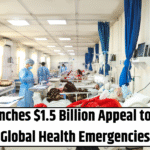A newly emerging COVID-19 variant, NB.1.8.1, has made its way to the United States, prompting health experts and global health authorities to closely monitor its progression as the summer season approaches. While not currently a dominant strain, the variant has been flagged by the World Health Organization (WHO) due to its rapid rise in several countries and its potential to be more infectious than currently circulating strains.
What We Know About NB.1.8.1
The WHO recently added NB.1.8.1 to its watch list after identifying a noticeable increase in cases across Europe, Southeast Asia, North America, and South America. According to initial analyses, this variant may spread more easily than the currently dominant LP.8.1 strain, but there’s no evidence it causes more severe disease or is significantly more resistant to vaccines or previous infections.
“It’s something we need to keep an eye on, but there’s no indication it’s going to cause a major surge in the U.S.,” said Dr. Andrew Pekosz, virologist at the Johns Hopkins Bloomberg School of Public Health.
NB.1.8.1 is part of the broader Omicron family, which has remained the primary lineage in circulation since late 2021. Like its predecessors, it appears to cause relatively mild symptoms in most people.
Growing Presence, But Still Rare in the U.S.
So far, fewer than 20 sequences of NB.1.8.1 have been confirmed in the U.S., according to the Centers for Disease Control and Prevention (CDC). That number is too small for the variant to be tracked on the CDC’s variant dashboard, which only includes strains making up at least 1% of cases.
Also Read – Health Care AI Falls Short on Savings, Relies Heavily on Human Labor
However, state surveillance programs have identified early cases. The Arizona Department of Health confirmed detecting three cases between April and May. Rhode Island and Ohio have also reported isolated cases, including at Cleveland Clinic facilities.
“It’s unclear whether this variant will take off or fade out,” said Dr. Thomas Russo, infectious disease chief at the University at Buffalo. “But our low booster rates could leave us vulnerable.”
Why Experts Are Cautiously Watching NB.1.8.1
Even though NB.1.8.1 doesn’t currently pose a significant health risk, infectious disease experts are urging caution due to two main factors:
-
U.S. booster rates remain low — fewer than 25% of adults have received the most recent COVID booster.
-
No major wave has hit in months, which means population-level immunity could be waning.
“If a more transmissible variant appears when community immunity is low, even a small shift in the virus could lead to a noticeable uptick in cases,” warned Dr. Scott Roberts, associate medical director of infection prevention at Yale School of Medicine.
Historically, COVID surges in the U.S. tend to peak in summer and winter, making this a prime time for a potential resurgence, regardless of the variant.
Dominance in China Hints at Potential Global Spread
NB.1.8.1 has already overtaken other variants in China, where it accounts for nearly 11% of all reported sequences, according to data from GISAID, a global virus tracking platform. This is up from just 2.5% earlier in the same month.
A preprint study suggests NB.1.8.1 carries mutations that may enhance its ability to spread. However, the study has not yet undergone peer review, so conclusions about its potential global dominance are still preliminary.
Vaccine Effectiveness and Future Outlook
Current COVID-19 vaccines, especially the 2023–2024 boosters targeting the JN.1 strain, are expected to offer some cross-protection against NB.1.8.1 due to its similar structure.
In preparation for the fall, the FDA has asked vaccine manufacturers to update COVID shots to target the LP.8.1 strain. Early lab results from Pfizer and Moderna indicate that these new formulations should also work against NB.1.8.1 to a significant degree.
Also Read – Five Years After Covid, Rural Hospitals Still Face Doctor and Nurse Shortages
But the FDA plans to restrict eligibility for these updated boosters to:
-
Older adults
-
Children and teens with high-risk medical conditions
In a controversial move, the CDC has also withdrawn its recommendation for routine COVID-19 vaccination among healthy children and pregnant women, citing shifts in population-level risk.
This decision has drawn criticism from public health leaders, including Dr. Roberts, who said there was no substantial new data to support such policy changes.
Potential Gaps in Protection
Doctors are warning that reduced vaccination guidance could lead to increased vulnerability among:
-
Pregnant individuals
-
Children under five
-
Unboosted adults with waning immunity
“Even if you’ve had two or three shots, your protection may not be optimal anymore,” said Dr. Russo. “The virus evolves and our immune defenses fade over time.”
What You Can Do Now
If you haven’t received a COVID booster in the past year and are eligible, now is the time, according to health experts. While NB.1.8.1 is still rare in the U.S., its growing presence abroad and ability to spread quickly could shift the landscape in the coming months.
Also Read – New Effort by Health Insurers Aims to Simplify Prior Authorization
Key Takeaways
-
NB.1.8.1 is a new COVID variant now detected in the U.S.
-
It spreads faster than the current LP.8.1 variant but doesn’t appear more dangerous.
-
Low booster uptake and a long quiet period could pave the way for a summer surge.
-
Updated fall vaccines are in development, but eligibility may be limited.
-
Experts urge caution, especially for vulnerable groups and the unvaccinated.
As always, staying informed, vaccinated, and aware of emerging health guidance remains the best defense against future waves of COVID-19.



